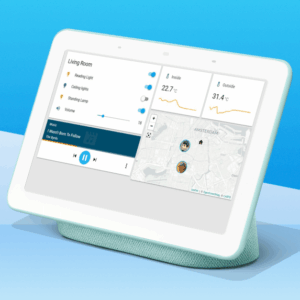Are you new to the world of smart home automation and looking for a powerful, flexible, and private way to manage your devices? Look no further than Home Assistant! This comprehensive guide will introduce you to Home Assistant, explain what it can do, and why it’s becoming the top choice for homeowners seeking true control over their digital living spaces.
What is Home Assistant?
Home Assistant is free and open-source software designed to be a centralized home automation platform. It acts as a smart home controller, serving as a smart home hub and an integration platform that emphasizes local control and privacy above all else. Unlike many commercial smart home systems, Home Assistant is built to be independent of any specific Internet of Things (IoT) ecosystem, meaning it doesn’t have to rely on cloud services to function. This gives users a single point of control for various smart home devices, regardless of their manufacturer or brand.
The project is backed by a worldwide community of tinkerers and DIY enthusiasts and is a non-profit initiative by the Open Home Foundation, ensuring it cannot be sold or acquired.
What Can You Do with Home Assistant?
Home Assistant offers a wide array of capabilities that allow you to truly awaken your home:
- Integrate Over 1000 Brands and Devices: Home Assistant can integrate with a vast number of devices and services, automatically scanning your network for known devices upon startup for easy setup. It supports common wired and wireless communication protocols like Bluetooth, Zigbee, Z-Wave, EnOcean, Thread/Matter, Wi-Fi, and Ethernet. This broad compatibility means you’re not limited to a single brand or ecosystem.
- Powerful Automations: Once your devices are integrated, you can unleash Home Assistant’s advanced automation engine to make your home work for you. You can create custom routines based on triggers (like motion detection or time of day), conditions (like light level or specific dates), and actions (like turning on lights or sending alerts). Examples include turning on lights when the sun sets, alerting you if a garage door is left open, or pausing your HVAC system when a window is open. Automations can be built using a user-friendly graphical interface, though advanced users can still access the underlying YAML code for more complex setups.
- Versatile Dashboards: Create customizable dashboards to display information about and manage your smart home from your mobile device or desktop. Dashboards allow for drag-and-drop customization and feature various card types to visualize data and control devices, such as toggling lights, adjusting thermostats, or viewing security camera feeds.
- Intuitive Voice Assistants: Control Home Assistant using natural language through its own private and fast voice assistant called Assist. You can also integrate popular voice assistants like Amazon Alexa and Google Assistant. Assist is built on an open voice foundation and can be customized, supporting wake words and running on affordable hardware, including mobile phones, tablets, smartwatches, and even old telephones.
- Comprehensive Home Energy Management: Gain new insights into your energy usage, optimize solar panel production, plan consumption, and save money with Home Assistant’s energy management feature. It allows you to monitor electricity grid usage, solar panel production, battery storage, gas, water, and individual device usage.
- Device Organization: Organize your smart home using areas, labels, and zones. Areas can represent rooms or logical groupings, while zones can be geofences around locations like your home, office, or grocery store, enabling automations based on presence detection.
- Extend Functionality with Add-ons: Easily install third-party applications, known as add-ons, to extend your system’s capabilities. Examples include running a DNS-based ad blocker like AdGuard, utilizing automation engines like NodeRed, or turning Home Assistant into a Spotify Connect target. The Home Assistant Community Store (HACS) also allows you to manage custom elements like dashboard features and integrations for devices without official support.
- Mobile Apps: Use the official Home Assistant companion apps for Android and iOS for convenient control and notifications, even on devices like Apple Watch. These apps can send your location home for presence detection without third-party access, as data is sent directly to your local system.
- NFC Tags and Home Assistant Cast: Utilize NFC tags for quick automations or displaying dashboards on any TV using Home Assistant Cast.
Why People are Choosing Home Assistant
People are increasingly turning to Home Assistant for several compelling reasons: - Unrivaled Local Control and Privacy: Home Assistant prioritizes local control, meaning your smart home data stays within your home, not in the cloud. This enhances security by eliminating reliance on external cloud services and prevents unauthorized access to your personal data.
- Open Source and Community-Driven: Being open source, Home Assistant benefits from a massive and active worldwide community of developers and users. This fosters rapid innovation, continuous improvements, and a wealth of shared knowledge and resources. In 2024, Home Assistant was recognized as the top open source project on GitHub by contributors.
- True Interoperability: Home Assistant acts as a universal translator for your smart devices, bridging different brands and technologies. This means you’re not locked into a single brand’s ecosystem and can choose the best devices for your needs, knowing they can all work together seamlessly.
- Cost-Effective and Flexible: The software itself is free, and you have various hardware options for installation, from affordable single-board computers like a Raspberry Pi or the purpose-built Home Assistant Green to more powerful x86 machines. This flexibility allows you to scale your system as your needs grow.
- Empowering the DIY Enthusiast: Home Assistant caters to those who enjoy tinkering and customizing. While it once had a steeper learning curve, newer versions offer graphical user interfaces for most setups and automations, making it more user-friendly for beginners. For advanced users, the underlying YAML configuration remains accessible for deep customization.
- Robust Troubleshooting Tools: Home Assistant provides powerful tools like History, Logbook, and Traces to help you understand what’s happening in your smart home and diagnose issues. This transparency helps you quickly identify why an automation did or did not run as expected.
Getting Started with Home Assistant
The easiest way to begin your Home Assistant journey is by purchasing Home Assistant Green. This device comes with Home Assistant pre-installed, offering a simple plug-and-play experience that only requires an Ethernet connection.
For those who prefer a more DIY approach, you have many additional options: - Raspberry Pi: A small, popular computer that’s a great introduction to DIY smart home skills.
- Mini PC (x86 machine): For those seeking maximum speed and future-proofing, allowing for more complex projects like virtualization and Docker containers.
- Other Devices: Home Assistant can also run on ODROID devices, Network-Attached Storage (NAS) systems, or in a virtualized environment.
Once installed, Home Assistant will guide you through setting up integrations for your devices, creating your first automations, and building personalized dashboards.
Embrace the Future of Smart Living
Home Assistant empowers you to create a truly intelligent home that respects your privacy and works exactly how you want it to. With its strong focus on local control, vast compatibility, and a vibrant community, it offers a level of customization and security that traditional smart home platforms often lack. Whether you’re just starting out or looking to upgrade your existing setup, Home Assistant provides the tools to build your ideal smart home.

